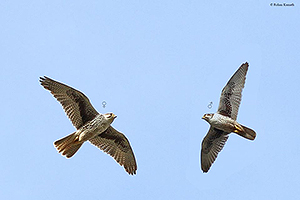 |
Prairie Falcon
Falco mexicanus |
|
STANFORD LOCATIONS: Rarely seen on campus. Similar Species: Peregrine Falcon |
 |
Location |
Type |
Mating System |
Parental Care |
2ndary Diet |
Strategy |
|
|
|
|
I: 29-33 DAYS SEMIALTRICIAL 2 |
|
|
|
(20 feet - 400 feet) |
|
(2-7) MONOG |
MF |
MAMMALS INSECTS LIZARDS |
.......PATROL |
| BREEDING: | Open habitat in mountainous regions, shortgrass prairie, alpine tundra. 1 brood. |
| DISPLAYS: | Male performs aerial gymnastics, cutting parabolas and calling in front of perched female; she calls, occ joins flight. Male also struts on nesting ledge. |
| NEST: | On cliff ledge, occ in rock crevice, always facing open habitat. Usu unlined. Rarely use earthen bank. |
| EGGS: | White/pinkish-white, marked with browns. 2.1" (52 mm). |
| DIET: | Can overtake most birds directly, flushing ground dwellers by flying low, but also hovers and stoops for other prey. |
| CONSERVATION: | Winters s to Baja, n Mexico. Some eggshell thinning and mercury poisoning reported (accumulated esp from taking seed-eating Horned Lark). Declining in UT, w Canada, and agricultural CA. |
| NOTES: | Weak nest site tenacity. Clutches smaller in e portion of range. In nest defense, male circles above, female leaves nest only as last resort. Parental care of young continues after fledging. Female ca. 33% larger than male. With lighter wing loading, outflies Peregrine at high altitude. |
| ESSAYS: | Raptor Hunting; Size and Sex in Raptors; Conservation of Raptors; Wing Shapes; Metallic Poisons; Site Tenacity. |
| REFERENCES: | Allen et al., 1986; Cade, 1982; Enderson, 1964; Marti and Braun, 1975. |
| Help | Abbreviations | Species-Alphabetical | Species-Taxonomic | Essays-Alphabetical | |
| Except for Stanford Locations, the material in this species treatment is taken, with permission, from The Birder's Handbook (Paul Ehrlich, David Dobkin, & Darryl Wheye, Simon & Schuster, NY. 1988). | |||||